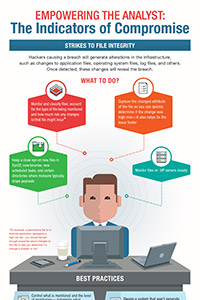Empowering the Analyst: Indicators of Compromise
Successfully assessing the threat conditions of an enterprise network is becoming an increasingly complicated task as attackers constantly adapt their tools and use new techniques to evade detection. Security analysts and enterprise IT managers need to stay vigilant and maintain a robust view of what they’re protecting. They have the hard task of collecting small and disparate clues that cumulatively indicate if an attacker has compromised their network—these clues are also known as Indicators of Compromise (IoC). Specifically, they are pieces of forensic data that can help analysts recognize malicious activity on a network. Spotting and handling these IoCs can help prevent the attacker from doing any lasting damage.
These guidelines for identifying and handling IoCs are particularly useful for businesses that:
- face serious compliance requirements or are subject to standards or regulation that state that data must be monitored or managed
- have a substantial on-site IT infrastructure of any kind—even mid-market businesses or small businesses
- have servers containing data critical to the business or highly sensitive data
- own and operate a data center
Like it? Add this infographic to your site:
1. Click on the box below. 2. Press Ctrl+A to select all. 3. Press Ctrl+C to copy. 4. Paste the code into your page (Ctrl+V).
Image will appear the same size as you see above.
Ultime notizie
- LLM as a Judge: Evaluating Accuracy in LLM Security Scans
- The Silent Leap: OpenAI’s New ChatGPT Agent Capabilities and Security Risks
- Trend Micro State of AI Security Report 1H 2025
- The Road to Agentic AI: Navigating Architecture, Threats, and Solutions
- Exploiting Trust in Open-Source AI: The Hidden Supply Chain Risk No One Is Watching





 Trend Micro State of AI Security Report 1H 2025
Trend Micro State of AI Security Report 1H 2025 AI in the Crosshairs: Understanding and Detecting Attacks on AWS AI Services with Trend Vision One™
AI in the Crosshairs: Understanding and Detecting Attacks on AWS AI Services with Trend Vision One™ Trend 2025 Cyber Risk Report
Trend 2025 Cyber Risk Report The Road to Agentic AI: Navigating Architecture, Threats, and Solutions
The Road to Agentic AI: Navigating Architecture, Threats, and Solutions